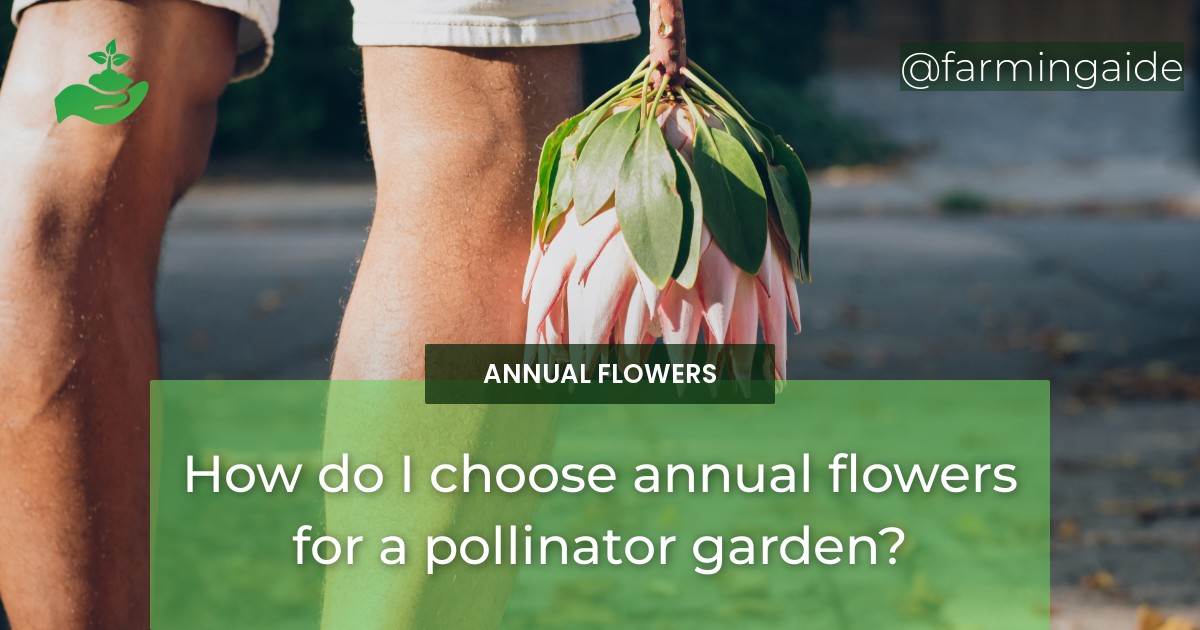A pollinator garden is a beautiful way to attract and support important pollinators like bees, butterflies, and hummingbirds. When choosing annual flowers for your pollinator garden, it’s important to consider several factors to ensure the blooms are nectar-rich and attractive to pollinators. This article will explore the factors to consider when selecting annual flowers for a pollinator garden and provide a list of the top annual flowers for a pollinator garden. We will also discuss how to create a pollinator-friendly garden by grouping flowers by color and height, providing water sources, adding nesting sites for native bees, avoiding invasive species, and offering maintenance tips to keep a pollinator garden healthy.
How to Choose Annual Flowers for a Pollinator Garden
Factors to Consider when Selecting Annual Flowers for a Pollinator Garden
Importance of Nectar-Rich Blooms
When selecting annual flowers for a pollinator garden, it’s essential to choose nectar-rich blooms that provide the necessary food source for pollinators. Bees, butterflies, and hummingbirds need nectar to fuel their activities, and planting flowers that produce this high-energy food source is a key factor in attracting and supporting these essential pollinators.
Host Plants for Pollinators
Another essential factor to consider when selecting annual flowers for a pollinator garden is to choose host plants for pollinators.
Seasonal Blooming Patterns
It’s important to choose annual flowers that bloom at different times throughout the growing season to provide a consistent food source for pollinators. By selecting a variety of annual flowers that bloom at different times, you can ensure a continuous food source for pollinators throughout the growing season.
Flower Colors that Attract Pollinators
When choosing annual flowers for a pollinator garden, it’s important to consider the colors of the blooms. Certain colors attract specific pollinators. For instance, hummingbirds are attracted to red, while bees are drawn to yellow, blue, and purple blooms.
Soil and Sunlight Requirements
Annual flowers have different soil and sunlight requirements. It’s essential to choose annual flowers that are well-suited to your particular garden conditions.
Pesticide-Free Gardening
When creating a pollinator garden, it’s important to avoid using pesticides and other chemicals that can harm pollinators. Instead, opt for natural pest control methods and organic gardening practices that are safe for pollinators.
Top Annual Flowers for a Pollinator Garden
Here are some of the top annual flowers for a pollinator garden:
Zinnias
- Zinnias are a popular choice for pollinator gardens because they produce large, colorful blooms that are nectar-rich and long-lasting.
- Zinnias are also easy to grow, making them an ideal choice for novice gardeners.
Sunflowers
- Sunflowers are another popular choice for pollinator gardens because they provide a substantial food source for pollinators.
- Sunflowers are nectar-rich and produce a large number of seeds that are a valuable food source for birds during the fall and winter months.
Cosmos
- Cosmos are a lovely addition to a pollinator garden as they produce beautiful daisy-like blooms that are attractive to bees and butterflies.
- Cosmos are also an excellent cut flower, making them a popular choice for bouquets and floral arrangements.
Marigolds
- Marigolds are an easy-to-grow annual flower that produces bright, colorful blooms that attract pollinators.
- Marigolds are also known to repel pests in the garden, making them an ideal choice for organic gardening.
Nasturtiums
- Nasturtiums are a must-have for any pollinator garden as they produce bright, showy blooms that are attractive to pollinators.
- Nasturtiums also have edible leaves and flowers that can be used in salads or as a garnish.
Lantanas
- Lantanas are another nectar-rich annual flower that is attractive to pollinators.
- Lantanas bloom continuously throughout the growing season, providing a consistent food source for pollinators.
Sweet Alyssum
- Sweet Alyssum is a fragrant annual flower that produces small, delicate blooms that are attractive to bees and butterflies.
- Sweet Alyssum is also an excellent ground cover plant, making it an ideal choice for filling in bare spots in the garden.
Creating a Pollinator-Friendly Garden
Here are some tips for creating a pollinator-friendly garden:
Grouping Flowers by Color and Height
Grouping flowers by color and height can make it easier for pollinators to locate the blooms they need. Grouping similar colored flowers together can help pollinators distinguish between different flowers, while arranging flowers by height can provide an easier flight path for bees and butterflies.
Providing Water Sources
Providing water sources like shallow bird baths or small ponds can be beneficial for pollinators that need to drink water. Be sure to change the water regularly to prevent mosquitoes from breeding.
Adding Nesting Sites for Native Bees
Many species of native bees require nesting sites to lay their eggs. Providing nesting sites like hollow stems, wood blocks, or bee houses can help support native bee populations.
Avoiding Invasive Species
Avoid planting invasive species in your pollinator garden. Invasive plants can outcompete native plants and reduce the availability of food sources for pollinators.
Maintenance Tips to Keep a Pollinator Garden Healthy
Regular maintenance tasks like deadheading spent blooms, weeding, and trimming back overgrown plants can help keep a pollinator garden healthy and thriving.
Resources for Learning More About Pollinator Gardening
There are many resources available for learning more about pollinator gardening. Local nurseries, extension offices, and gardening clubs are excellent sources of information and advice.
Conclusion
Choosing the right annual flowers for your pollinator garden is essential to attract and support important pollinators like bees, butterflies, and hummingbirds. By considering factors like nectar-rich blooms, host plants for pollinators, seasonal blooming patterns, flower colors that attract pollinators, soil and sunlight requirements, and pesticide-free gardening, you can create a beautiful garden that supports pollinators throughout the growing season. By following the tips outlined in this article, you can create a pollinator-friendly garden that is beautiful, beneficial, and rewarding.
RELATED ARTICLES:


